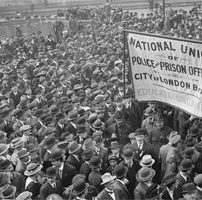
Violation of the freedom of expression of two persons convicted of burning a photograph of the Spanish royal couple in 2007
JUDGMENT
Stern Taulats and Roura Capellera v. Spain 13.03.2018 (no. 51168/15)
SUMMARY
Set a photography of the Royal couple of Spain on fire, which was placed upside down during a public demonstration. Imposition of a fine of EUR 2,700 or imprisonment of 15 months. Violation of freedom of expression, as this act was an expression of political criticism of the system of monarchy in general.
PROVISION
Article 10
PRINCIPAL FACTS
The applicants, Enric Stern Taulats and Jaume Roura Capellera, are two Spanish nationals who were born in 1988 and 1977 respectively. They live in Girona and Banyoles (Spain) respectively.
In September 2007, while the King was on an official visit to Girona, the applicants set fire, during a public demonstration, to a large photograph of the royal couple which they had placed upside-down.
As a result, they were sentenced to 15 months’ imprisonment for insult to the Crown. The judge subsequently replaced that penalty with a fine of 2,700 euros each but ruled that, in the event of failure to pay the fine in whole or in part, the applicants would have to serve the prison term. That judgment was upheld by the Audiencia Nacional on 5 December 2008. When the judgment became final the applicants paid the fine. However, they lodged an amparo appeal with the Constitutional Court, which concluded that the act with which they had been charged fell outside the scope of freedom of expression and freedom of opinion, given that the applicants had been guilty of incitement to hatred and violence against the King and the monarchy.
THE DECISION OF THE COURT
Article 10
The Court noted that the applicants’ conviction amounted to an interference with their right to freedom of expression, that the interference was prescribed by law and that it pursued a legitimate aim, namely the protection of the reputation or rights of others. As regards its necessity in a democratic society, the Court noted the following: First of all, the applicants’ act had been part of a political, rather than personal, critique of the institution of monarchy in general, and in particular of the Kingdom of Spain as a nation. The impugned “staged event” had been part of a debate on issues of general interest, that is to say the independence of Catalonia, the monarchic structure of the State and a critique of the King as a symbol of the Spanish nation. It had not been a personal attack on the King of Spain geared to insulting and vilifying his person, but a denunciation of what the King represented as the Head and the symbol of the State apparatus and the forces which, according to the applicants, had occupied Catalonia – which fell within the sphere of political criticism or dissidence and corresponded to the expression of rejection of the monarchy as an institution.
Secondly, the Constitutional Court had questioned the way in which the applicants had expressed their political criticism (use of fire and of a large upside-down photograph), considering that their mode of expression had spilled over from the sphere of freedom of expression into that of hate speech and incitement to violence.
The Court took the view that the applicants had used symbolical elements clearly and manifestly linked to their practical political criticism of the Spanish State and its monarchical form: the effigy of the King of Spain was the symbol of the King as the Head of the State apparatus; using fire and turning the photograph upside-down expressed a radical rejection or refusal, and those two elements were used as the manifestation of criticism of a political or other nature; the size of the photograph appeared to have been intended to ensure the visibility of the act in question, which had taken place in a public square. The applicants’ act had therefore been one of the provocative “events” which were increasingly being staged to attract media attention and which merely used a certain permissible degree of provocation to transmit a critical message in the context of freedom of expression.
Thirdly, the applicants’ intention had not been to incite anyone to commit acts of violence against the King, even though the “performance” had entailed burning an image of the figurehead of the State. Indeed, an act of this type should be interpreted as the symbolic expression of dissatisfaction and protest. Even though the “staged event” had involved burning an image, it was a means of expressing an opinion in a debate on a public-interest issue, namely the monarchy institution. The Court reiterated in that context that freedom of expression extended to “information” and “ideas” that offended, shocked or disturbed: such were the demands of pluralism, tolerance and broad-mindedness, without which there was no “democratic society”.
Fourthly, the Court was not convinced that the impugned act could reasonably be construed as incitement to hatred or violence. In the present case, incitement to violence could not be deduced from the joint examination of the “props” used for staging the event or from the context in which it had taken place; nor could it be established on the basis of the consequences of the act, which had not led to violent behaviour or disorder. Furthermore, the facts could not be considered as constituting hate speech, given the irrelevance of Article 17 of the Convention (prohibition of abuse of rights) to the present case.
Fifthly, the criminal penalty imposed on the applicants – a prison sentence, to be executed in the event of failure to pay the fine – amounted to an interference with freedom of expression which had been neither proportionate to the legitimate aim pursued nor necessary in a democratic society.
The Court therefore found a violation of Article 10 of the Convention. It also deemed unnecessary any separate consideration of the complaint under Article 9 concerning the same facts.
Just satisfaction (Article 41)
The Court held that the finding of a violation was sufficient just satisfaction for the non-pecuniary damage sustained by the applicants. It also held that Spain was to pay each of the applicants 2,700 euros (EUR) in respect of pecuniary damage and EUR 9,000, to the applicants jointly, in respect of costs and expenses (echrcaselaw.com editing).


